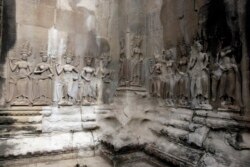The new coronavirus has left its mark on Angkor Wat, the world’s top tourist attraction.
Foreign visitors are rare, the elephants are being rehoused and local businesses have gone bankrupt, but for Cambodians, it’s a chance to reclaim their heritage.
Authorities say the number of paying visitors have been measured by the dozens on any given day and all are among those who remained in the country after the coronavirus began crossing borders in late January, forcing lockdowns around the world and ending international travel.
That compares with more than 2.2 million tourists who last year paid almost $100 million to get through the gates of the 12th-century temple, which covers 208 hectares.
“I find it very interesting without the tourists, because we usually have a lot of people out there and when we go there it's just like you are visitors, not the real people who own this country, but now it’s very good,” Sreynath Sarum, a hospitality worker from Phnom Penh, said.
Cambodia’s tourism industry had blossomed over the last 10 to 15 years with Angkor Wat, the ruins and surrounding temples in the country’s northwest consistently winning international awards, and the nearby town of Siem Reap was rebuilt into a tourist hub.
Mass tourism also brought problems, though.
Long lines at the gate, endless rows of buses, lines of Chinese visitors with selfie sticks, and Westerners in Hawaiian shirts, shorts and joggers had turned a sacred religious site of Hindu gods and Buddhist traditions into a carnival theme park.
That doesn’t always sit well with the monks and ordinary Khmers who value Angkor Wat as the foundation of Cambodian society, a reminder that this country was once a regional superpower and as a symbol of survival during 30 years of bloody civil war.
Lonely Planet author and filmmaker Nick Ray said if there can be a positive side to a pandemic, then it was Cambodians reconnecting with their spiritual side.
“From an economic point of view, it’s pretty tragic to see the absence of tourists. We know what that means for the economy and how badly businesses are hurting, like hotels, guesthouses, restaurants, cafes, bars, it’s like a ghost town, really,” he added.
“But from a Cambodian perspective, it’s like they’ve reclaimed the temples. It’s Cambodian ancestry, it’s Cambodian heritage, it’s on the flag, Angkor is the spiritual symbol of a nation, and they’ve really taken that to heart again.”
Angkor Wat today is not unlike it was two decades ago when the archaeological site was serenely quiet with the Khmer Rouge disarming but bandits and the widespread theft of ancient relics by organized crime rings were issues that had to be dealt with before opening the temples up to global tourism.
Standards of living have also improved over the last 20 years, and amid the ruins, Cambodian children are now riding push bikes and playing in sandpits, while their parents pray at Buddhist shrines and hike through tropical forests.
“I can’t imagine a time when Cambodians could go to Angkor Wat and pray in peace without hordes of people, or play badminton or picnic with their families – and that was a really kind of special experience to see,” travel writer Marissa Carruthers said.
“But like I say, it’s quite stark seeing the temples and Siem Reap completely shut down.”
The big bucks and crowds evaporated almost immediately as the COVID-19 pandemic took hold, and getting them back as lockdowns end remains tricky.
The government has announced a complicated set of rules including COVID-19 tests, medical certificates, health insurance, and a new type of visa for future holidaymakers.
If a passenger on an inbound flight displays any COVID-19 symptoms and tests positive, everyone on board could be quarantined for two weeks. Moreover, every foreign visitor to the country must deposit $3,000 in a local bank account on arrival to cover any costs.
Money that is not spent is expected to be returned, but these are moves that have upset the dormant tourism industry as unnecessary obstacles to be negotiated by travelers, particularly those from the West who already require at least two flights to get here.
“That’s pretty off-putting, to be honest,” Ray said regarding the deposit.
“It’s almost akin to saying, ‘You know, we are closed for business,’” he added.
Locals are also aware of the problems associated with COVID-19 and the harsh economic realities caused by the disease.
“I would like to have the tourists come back because the people out there, they are struggling a lot, but slowly, slowly, not like a million people come back at the same time,” Sreynath Sarum said.









